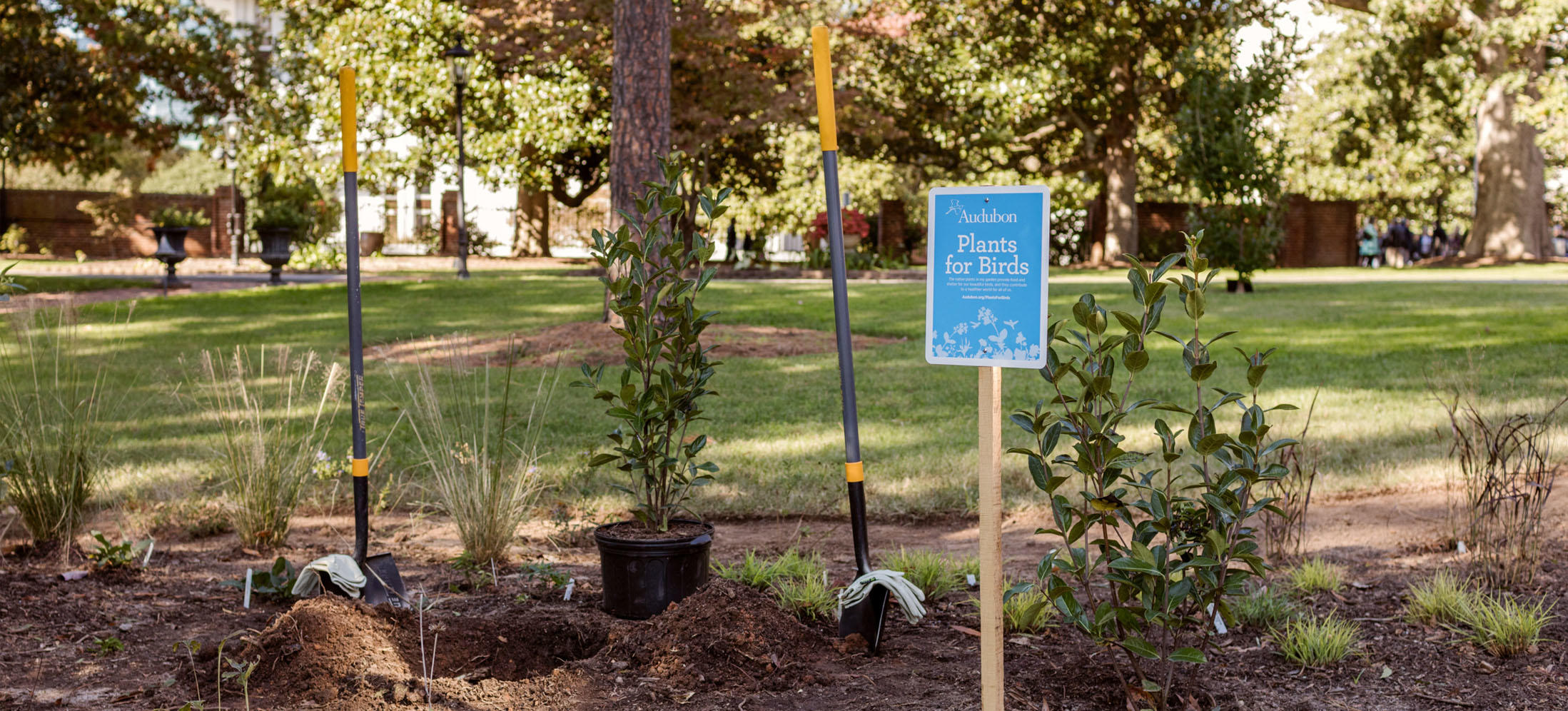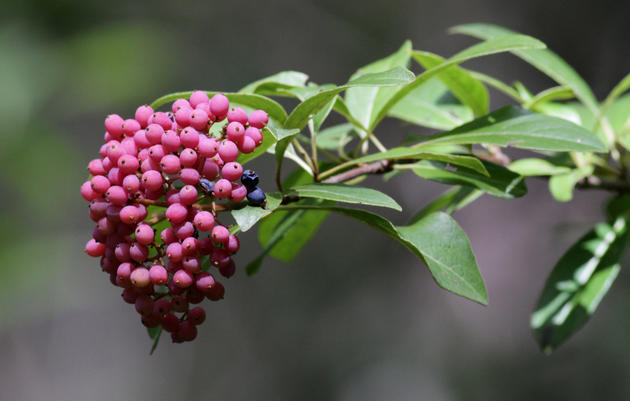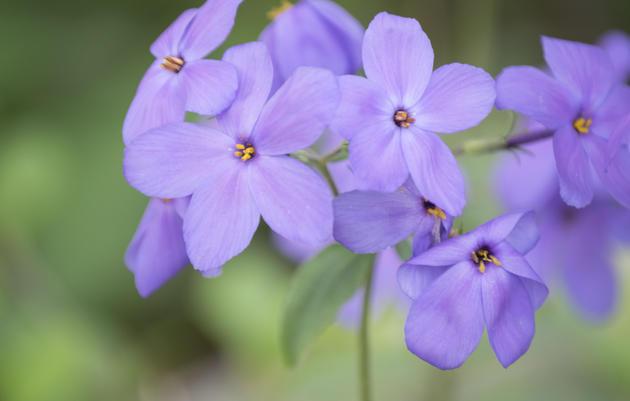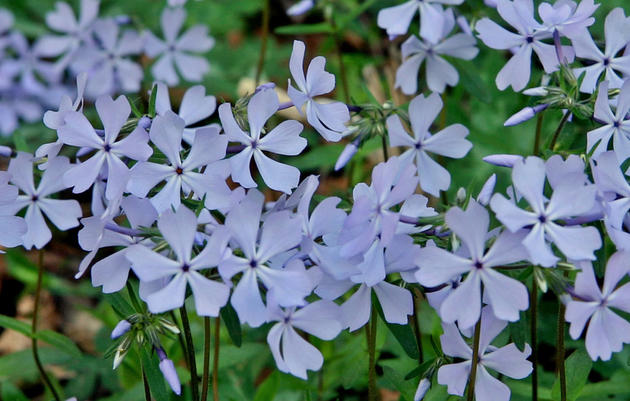Earlier this year, North Carolina’s First Lady Kristin Cooper reached out to Audubon North Carolina with an exciting opportunity—the chance to help establish a bird and pollinator-friendly garden at the Executive Mansion! See the final results, and get a behind-the-scenes look at the dedication ceremony, here.
The Executive Mansion is the official residence of the Governor and First Family, and an important location for public announcements, meetings and events. It offers an incredible platform to showcase North Carolina’s native plants and natural heritage.
The original Victorian garden at the Executive Mansion, planted by Dottie Martin, had become overgrown over the years with privet (Ligustrum) hedges and lost much of its original color and vibrancy. Audubon played a lead role in designing and fundraising for the refreshed garden, which will now benefit pollinators, birds and other wildlife.
In coordination with the dedication of the Executive Mansion native plant garden, Governor Cooper declared the final week of October “Native Plants Week” to encourage North Carolinians to plant native plants at their homes, yards and businesses.
Find native plants – and the birds they benefit – for your zip code here.
How Did the Garden Grow?
New Hope Audubon Society volunteer and landscape specialist, Ben Skelton, created the design for the bird and pollinator-friendly garden, drawing from Audubon North Carolina’s Bird-Friendly Native Plants list, and working in partnership with the First Lady and Executive Mansion gardener, Charles Dixon.
Ben owns a landscaping business focused on native plants – a shift he made after getting involved with New Hope Audubon’s bird-friendly yard certification team. He readily agreed to create a landscape design for the ultimate bird-friendly yard: North Carolina’s Executive Mansion!
How Native Plants Help our Birds
Many native plants already flourish on the property, and the new bird and pollinator garden will provide additional sources of food and habitat for birds and other pollinators.
Caterpillars (aka Baby Bird Food)
Big, gorgeous native oaks already grace the property, providing shade and ensuring that the chickadees, robins, and goldfinches who raise their babies there get plenty of caterpillars to eat. New plants like native blueberries (Vaccinium), Goldenrod (Solidago rugosa, “Fireworks”), and Possumhaw (Viburnum nudum) will support over 100 species of caterpillars for these birds!
Berries
Our state flower, the Flowering Dogwood, already grows in the bird and pollinator garden. Each fall, this tree offers up some very nutritious berries, perfectly timed to support birds like the Wood Thrush that can fly up to 300 miles in one night and often stop by downtown Raleigh during their migration journeys south. New plants in the garden will provide even more fatty berries for migrating birds and birds that overwinter, including Possumhaw (Viburnum nudum “Winterthur”) and Small-leaf Arrowwood (Viburnum obovatum “Raulston’s Hardy”).
Nectar
A cascade of flowers blooming across three seasons will attract and feed a bevy of pollinators from Ruby-throated Hummingbirds to Monarch butterflies. Dwarf Crested Iris (Iris cristata), Coastal Sweet Pepperbush (Clethra alnifolia), and Foamflower (Tiarella cordifolia) are just a few of the 20 varieties of flowers that will grow in the new garden.
Seeds
Seeds follow flowers, and the new garden will have plenty of seeds for our state bird, the Northern Cardinal, to eat, along with other big-beaked birds like Eastern Towhees, American Goldfinches and Song and White-throated sparrows. Native perennials including Goldenrod, Black-eyed Susan, and Purple Coneflower will be complemented by showy, colorful seed-producing native grasses like Little Bluestem (Schizachyrium scoparium) and Pink Muhly Grass (Muhlenbergia capillaris).
Plant Your Own “Executive Garden” With These First Lady Favorites
Over 1,000 new bird-friendly native plants were added to the Executive Mansion garden, with 25 plant species represented (see the full list in PDF form here)! You don’t have to live in the Executive Mansion to build your own “Executive Garden.” Consider planting any of the following types of plants “en masse” so pollinators can forage. You’ll create a rich environment and food source for birds and other pollinators!
Purple Coneflower (Echinacea purpurea)
First Lady Kristin Cooper loves American Goldfinches, and we can’t think of a prettier plant to attract and feed them than Purple Coneflower. The pink-purple flowers are also popular with a variety of butterflies, bees, and other pollinators seeking nectar. Flowers June through August; ripe seeds August through November.
Eastern Columbine (Aquilegia canadensis)
Each spring, Columbine flowers are ready and waiting for the first Ruby-throated Hummingbirds of the year to arrive after their long nonstop flight across the Gulf of Mexico and their journey north to our state. Columbine is important for hummingbirds that stay in North Carolina and raise babies as well as for those just stopping by to refuel on their way north. Columbine offers hummers good Southern hospitality! Flowers March through May.
Butterfly Milkweed (Asclepias tuberosa)
Butterfly Milkweed is a host plant for Monarch butterflies, and the bright orange flowers of Butterfly Milkweed will be ready to support the bright-orange “flutter-by’s” as they journey south in the fall. Many other butterfly species, plus bees and other pollinators, will visit for a sip of nectar, too! Flowers May through August.
Possumhaw (Viburnum nudum)
Songbirds gobble up native berries to fatten up and fuel their journey south for the winter. Possumhaw is a popular one for larger songsters like Wood Thrushes, Swainson’s Thrushes, and Gray Catbirds. Berries will last into the cold months, feeding our year-round-resident birds like the Northern Mockingbird, the Brown Thrasher, and the Cedar Waxwing. Flowers April through May; berries August through December.
Joe Pye Weed (Eutrochium fistulosum)
In summer and fall, the mauve flowers of Joe Pye Weed are magnets for many butterflies, including the North Carolina State Butterfly, the Eastern Tiger Swallowtail, and Monarch butterflies making their journey south. Flowers July through August, seeds August through November.
Find native plants – and the birds they benefit – for your zip code here.
More information about native plants, birds, pollinators, and invasive plants is available from our partner organizations:
North Carolina Native Plant Society
North Carolina Botanical Garden
North Carolina Cooperative Extension Service
https://projects.ncsu.edu/goingnative/
Xerces Society
North Carolina Wildlife Federation
http://ncwf.org/programs/garden-for-wildlife/butterfly-highway/
Carolina Butterfly Society
http://carolinabutterflysociety.org/
North Carolina Wildlife Resources Commission
http://www.ncwildlife.org/WISe/Landscaping-with-Native-Plants










